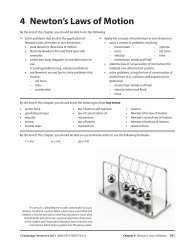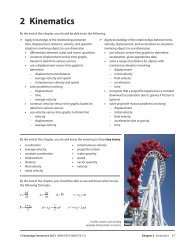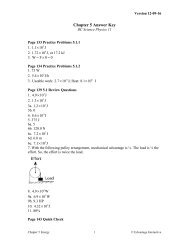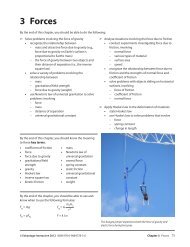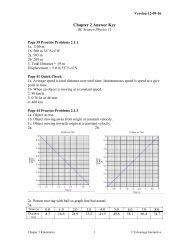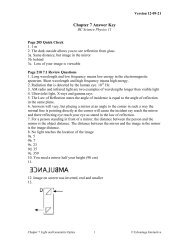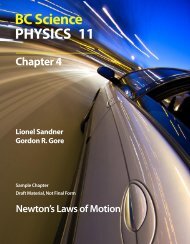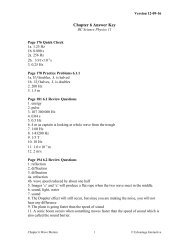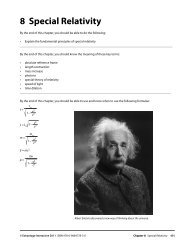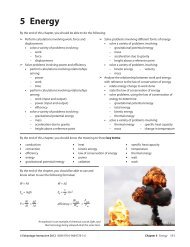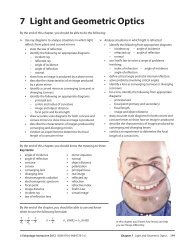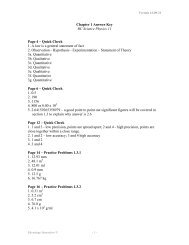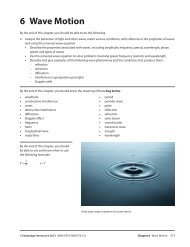1 Skills, Methods, and the Nature of Physics - BC Science Physics 11
1 Skills, Methods, and the Nature of Physics - BC Science Physics 11
1 Skills, Methods, and the Nature of Physics - BC Science Physics 11
You also want an ePaper? Increase the reach of your titles
YUMPU automatically turns print PDFs into web optimized ePapers that Google loves.
Combining<br />
Measurements<br />
Imagine that you have a laboratory bench that is 1.756 m long. The last digit (in italics)<br />
is an estimate to <strong>the</strong> nearest millimetre. You might call it an uncertain digit. Perhaps a<br />
truer measure might be 1.755 m or 1.757 m. Often you must estimate <strong>the</strong> last digit in a<br />
measurement when you guess what a reading is between <strong>the</strong> smallest divisions on <strong>the</strong><br />
measuring scale. This is true whe<strong>the</strong>r you are using a metre stick, a graduated cylinder, a<br />
chemical balance, or an ammeter.<br />
Adding or Subtracting Measurements<br />
Now imagine that you decide to add some thin plastic trim to <strong>the</strong> two ends <strong>of</strong> your<br />
bench. The trim has a width <strong>of</strong> 2.2 mm, which is 0.0022 m. What is <strong>the</strong> total length <strong>of</strong> <strong>the</strong><br />
bench with <strong>the</strong> new trim added?<br />
You add <strong>the</strong> widths <strong>of</strong> <strong>the</strong> two trimmed edges to <strong>the</strong> original length <strong>of</strong> <strong>the</strong> bench,<br />
like this:<br />
1.756 m<br />
0.0022 m<br />
0.0022 m<br />
1.7604 m = 1.760 m<br />
There is no point in carrying <strong>the</strong> last digit in <strong>the</strong> total. Since <strong>the</strong> 6 in 1.756 is<br />
uncertain, this makes <strong>the</strong> 0 in 1.7604 also uncertain, <strong>and</strong> <strong>the</strong> 4 following it a meaningless<br />
number. The proper way to write <strong>the</strong> total width <strong>of</strong> <strong>the</strong> bench is with just one uncertain<br />
digit, 1.760 m.<br />
Now imagine you have a graduated cylinder containing 12.00 mL <strong>of</strong> water.<br />
You carefully lower a glass marble into <strong>the</strong> graduated cylinder, <strong>and</strong> observe that <strong>the</strong> water<br />
level rises to 14.20 mL. What is <strong>the</strong> volume <strong>of</strong> <strong>the</strong> glass marble? To find out, you subtract<br />
<strong>the</strong> two measurements:<br />
14.20 mL<br />
–12.00 mL<br />
2.20 mL<br />
Notice that when <strong>the</strong> two measurements are subtracted, you lose a significant digit<br />
in this particular situation. What if <strong>the</strong> object added to <strong>the</strong> water was a small lead pellet<br />
<strong>and</strong> <strong>the</strong> volume increased from 12.00 mL to 12.20 mL? The volume <strong>of</strong> <strong>the</strong> pellet would<br />
be 0.20 mL. This measurement has only two significant digits. When measurements are<br />
subtracted, <strong>the</strong>re is <strong>of</strong>ten a loss <strong>of</strong> precision.<br />
Here is a common sense rule for adding or subtracting measurements:<br />
When adding or subtracting measurements, <strong>the</strong> sum or difference will have as many<br />
digits after <strong>the</strong> decimal point as <strong>the</strong> single measurement with <strong>the</strong> least number <strong>of</strong><br />
digits after <strong>the</strong> decimal point.<br />
© Edvantage Interactive 2012 ISBN 978-0-9864778-3-6 Chapter 1 <strong>Skills</strong>, <strong>Methods</strong>, <strong>and</strong> <strong>the</strong> <strong>Nature</strong> <strong>of</strong> <strong>Physics</strong> 13



